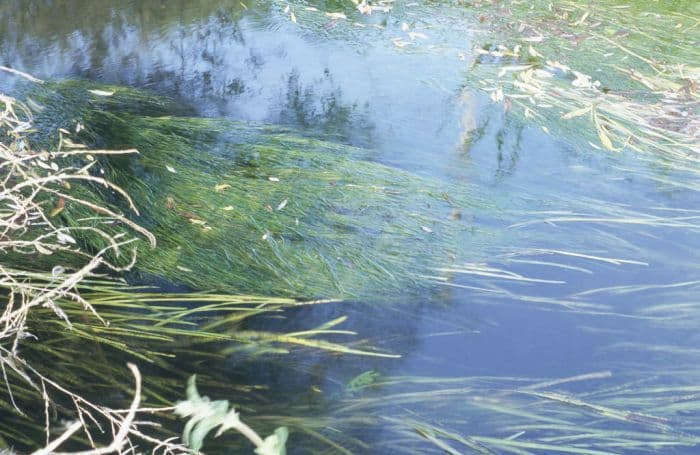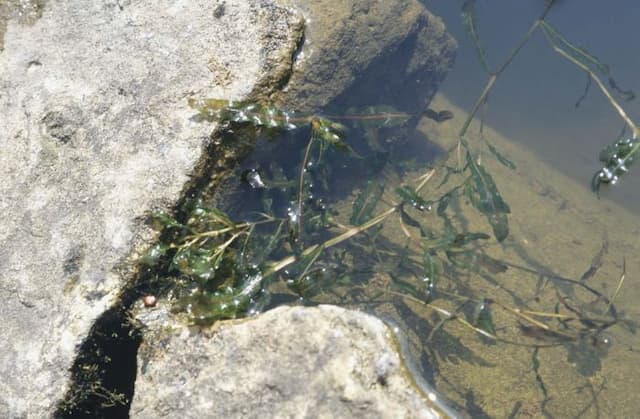Sago pondweed Potamogeton pectinatus

ABOUT
The common name for Potamogeton pectinatus is sago pondweed. This aquatic plant is often found in freshwater environments such as ponds, lakes, rivers, and streams. Sago pondweed has a distinct appearance characterized by its long, slender, and branching underwater stems. These stems are flexible and give the plant an overall flowing look in the water currents. Affixed to these stems are the leaves, which are very narrow and thread-like, resembling fine grass strands. The texture of the leaves is typically smooth, and they often have a slightly opaque or translucent quality, allowing some light to pass through. The foliage is arranged in an alternate pattern along the stems which adds to the feathery appearance of the plant when viewed as a whole. During certain times of the year, sago pondweed may produce small flowers that are inconspicuous and not particularly showy. These flowers develop on spikes that emerge above the water surface, but they are often unnoticed amongst the greater density of its foliage. Sago pondweed plays a significant role in its habitat, both as a source of food for wildlife and as a contributor to the aquatic environment's health, by providing oxygen and improving water quality. Its presence is usually an indicator of good water conditions and it is commonly found across various regions where it serves as an essential part of the ecosystem.
About this plant
 Names
NamesFamily
Potamogetonaceae.
Synonyms
Sago Pondweed, Fennel Pondweed, Slimy Pondweed, Hairgrass.
Common names
Potamogeton filiformis, Stuckenia pectinata, Potamogeton pectinatus var. filiformis, Potamogeton pectinatus var. gemmiparus, Potamogeton pectinatus subsp. filiformis, Coleogeton pectinatus, Potamogeton pectinatus var. lanuginosus, Potamogeton pectinatus var. pectinatus, Potamogeton pectinatus var. thermalis, Potamogeton filiformis var. arabicus, Potamogeton filiformis var. capillaceus, Potamogeton filiformis var. coloratus, Potamogeton filiformis var. hamatus, Potamogeton filiformis var. laxus, Potamogeton pectinatus var. sibiricus, Potamogeton pectinatus var. zizii.
 Toxicity
ToxicityTo humans
Sago pondweed (Potamogeton pectinatus) is generally not considered toxic to humans. It is actually a source of food in some parts of the world, and there is no widespread documentation of its toxicity upon ingestion. Thus, eating sago pondweed normally does not lead to poisoning symptoms in humans.
To pets
Sago pondweed is not known to be toxic to pets. Similar to its effects on humans, there is no significant evidence to suggest that ingestion of sago pondweed by animals would lead to poisoning. Pets that ingest parts of this plant are unlikely to experience adverse symptoms solely due to its toxicity. However, as with any non-familiar food, individual animals might experience digestive upset or an allergic reaction.
 Characteristics
CharacteristicsLife cycle
Perennials
Foliage type
Deciduous
Color of leaves
Green
Flower color
Greenish
Height
1-3 feet (0.3-0.9 meters)
Spread
1-3 feet (0.3-0.9 meters)
Plant type
Herb
Hardiness zones
4-10
Native area
Eurasia
Benefits
 General Benefits
General Benefits- Ecosystem support: Provides habitat and food for aquatic fauna such as fish and macroinvertebrates.
- Water quality improvement: Absorbs excess nutrients from the water, helping to mitigate eutrophication.
- Erosion control: Stabilizes sediment with its root system, reducing turbidity and protecting water bodies from sedimentation.
- Oxygen production: Like all photosynthetic plants, it releases oxygen underwater, which is essential for aquatic life.
- Recreational use: Supports healthy fish populations for angling and maintains clear waterways for boating and swimming.
- Aesthetic value: Contributes to the natural beauty of water bodies with its underwater foliage.
- Substrate for epiphytes: Provides a surface for algae and other small plants to grow on, increasing biodiversity.
- Shading: Helps to moderate water temperature and light penetration, creating a balanced aquatic environment.
 Medical Properties
Medical PropertiesThis plant is not used for medical purposes.
 Air-purifying Qualities
Air-purifying QualitiesThis plant is not specifically known for air purifying qualities.
 Other Uses
Other Uses- Potamogeton pectinatus, commonly known as sago pondweed, can be used as a food source for waterfowl, providing a high-energy food in the form of tubers and seeds.
- Sago pondweed can serve as a habitat for fish and macroinvertebrates, offering shelter and breeding grounds within its dense underwater beds.
- The plant plays a role in nutrient cycling within aquatic ecosystems by absorbing and storing nutrients, which can help reduce eutrophication.
- It can be used in the craft of basketry and weaving, particularly by Indigenous peoples who have traditionally used aquatic plants for these purposes.
- Sago pondweed may be incorporated into ornamental ponds and water gardens for aesthetic purposes due to its fine, feathery underwater foliage.
- The plant’s extensive root system helps to stabilize sediment and shorelines, reducing erosion in aquatic environments.
- Sago pondweed is utilized in the food industry as food for cultured species like carp, which feed on the plant in fish farming operations.
- It is part of a constructed wetland system for wastewater treatment, where it can assist in the removal of pollutants from water.
- Due to its rapid growth, sago pondweed can be harvested and composted as a form of organic matter for soil conditioning.
- The plant can act as a bioindicator of water quality, with its presence and health reflecting the condition of the aquatic environment.
Interesting Facts
 Feng Shui
Feng ShuiThe Sago Pondweed is not used in Feng Shui practice.
 Zodiac Sign Compitability
Zodiac Sign CompitabilityThe Sago Pondweed is not used in astrology practice.
 Plant Symbolism
Plant Symbolism- Adaptability: Potamogeton pectinatus, commonly known as Sago Pondweed, often thrives in various aquatic environments, symbolizing the ability to adapt and flourish under diverse conditions.
- Growth: As a fast-growing plant, Sago Pondweed signifies rapid growth and expansion, suggesting the potential for quick progress or development in certain aspects of life.
- Resilience: Sago Pondweed's capacity to survive in different water qualities and its resistance to disturbances in the aquatic ecosystem represent resilience and the power to recover from challenges.
- Nourishment: Given its role as a food source for waterfowl and aquatic life, Sago Pondweed symbolizes sustenance and the provision of essential needs.
 Water
WaterThe most common name for Potamogeton pectinatus is Sago Pondweed. Sago Pondweed is an aquatic plant, meaning it grows in water, thus traditional watering is not applicable. Instead, it is essential to maintain the water levels of the pond or aquatic habitat where it grows. The amount of water added will depend on the size of the body of water, evaporation rates, and any water extraction from the ecosystem. In a controlled setting such as a pond, it may be necessary to add several gallons of water monthly to compensate for water loss and to keep the pondweed submerged.
 Light
LightSago Pondweed thrives best in full sunlight, so it should be situated in a spot that receives direct sun for most of the day. This ensures the plant gets the energy it needs for photosynthesis. However, it can tolerate partial shade, especially in hot climates, but the growth might be less vigorous.
 Temperature
TemperatureSago Pondweed is adaptable to a range of temperatures but it performs best in water that remains between 65 to 77 degrees Fahrenheit. The plant can tolerate temperatures slightly above and below this range, but temperatures below 50 degrees Fahrenheit or above 86 degrees Fahrenheit can be harmful to the plant over time.
 Pruning
PruningPruning is beneficial for Sago Pondweed to prevent excessive growth and to maintain water flow and light penetration in the aquatic habitat. It should be pruned during the active growth season, which is typically in the summer months. Pruning can be done as needed when the plant mass becomes too dense, but it is advisable not to remove more than one-third of the growth at any one time to avoid stressing the plant.
 Cleaning
CleaningNot needed
 Soil
SoilSago pondweed (Potamogeton pectinatus) grows best in loamy, sandy, or silty substrates common in aquatic environments. It typically thrives in a pH range of 6.0 to 9.0, and the soil mix should mimic the plant's natural aquatic conditions by providing a base of inert sand or aquatic soil designed for pond plants.
 Repotting
RepottingSago pondweed does not require traditional repotting as it is an aquatic plant. Instead, it may occasionally need thinning or dividing to manage growth. This process is typically done every 2 to 3 years or when the plant population covers the water surface excessively.
 Humidity & Misting
Humidity & MistingSago pondweed is an aquatic plant and therefore does not require a specific humidity level as it grows submerged in water. Maintaining the water quality and levels in the pond or aquatic habitat ensures proper growth conditions for this species.
 Suitable locations
Suitable locationsIndoor
Grow Sago pondweed in a water tank with proper lighting.
Outdoor
Plant Sago pondweed in a pond or still water body.
Hardiness zone
4-10 USDA
 Life cycle
Life cyclePotamogeton pectinatus, commonly known as sago pondweed, begins its life cycle with seed germination, which occurs underwater in spring or early summer, requiring stable water temperature and light penetration. After germination, seedlings develop into submerged plants with long, slender stems connected to a root system anchored in the sediment. The plants grow rapidly, producing leaves and, in favorable conditions, form dense underwater meadows providing habitat for aquatic life. Sago pondweed reproduces both vegetatively by rhizomes and turions (overwintering buds) and sexually by flowering, with flowers reaching the water surface, where pollination mainly by wind occurs. After pollination, the flowers develop into fruits—small, nut-like seeds—which fall to the sediment and can remain viable for several years. As winter approaches, the above-ground parts die back while turions and seeds survive the cold months, ready to start the cycle again in spring.
 Propogation
PropogationPropogation time
Spring-Summer
Sago Pondweed, or Potamogeton pectinatus, is commonly propagated through its tubers. The most suitable time for its propagation is in the late winter or early spring when the water temperatures begin to rise. Tubers can be harvested from established plants and then directly planted in the sediment of a new location. This is typically done by burying the tubers 2 to 4 inches deep, making sure the sediment is loose enough for the tuber to establish its roots. Each tuber can give rise to a new plant, making this method efficient and widely used for expanding or managing populations of the sago pondweed in aquatic environments.
